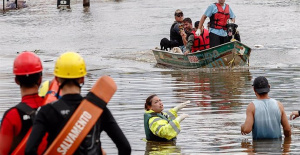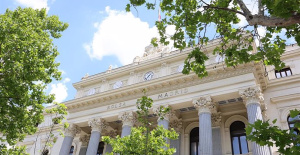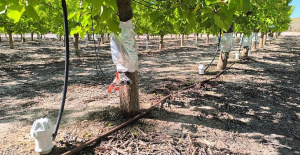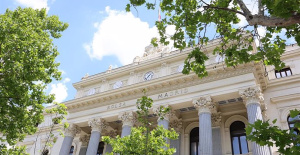The Security Forces do not rule out that the anger in Algiers will lead to a rebound, although without reaching the figures of the Alaouite country
MADRID, 12 Jun. (EUROPA PRESS) -
The migratory flow to the Canary Islands from Morocco continues to channel three times as many irregular arrivals as can be attributed to the 'Algerian route', despite the turn taken by Spain in supporting the Alauite plan on Western Sahara, which in the middle of March in the closure of the crisis with the Kingdom of Mohamed VI and, in parallel, the angry protest in Algiers that led this week to the suspension of the friendship treaty.
According to data from the Ministry of the Interior up to May 31 --compared to the same period in 2021--, migration attributable to the 'Moroccan route' to the Canary Islands has increased by 50%, adding 8,268 arrivals (in 181 boats). This is triple the 'Algerian route', to the Balearic Islands and other points on the Peninsula, which has decreased by 35% by registering 2,824 arrivals (in 274 boats) in the first five months of 2022.
Since March, when Moncloa endorsed the Moroccan plan on the Sahara by letter, giving way to a "new stage" in bilateral relations -- with the consequent anger of Algeria staged this week by announcing the break in trade relations -- arrivals in the Canary Islands have increased month by month: 431 in March, 697 in April and 1,644 in May.
These figures are still very far from those recorded by sea to the Balearic Islands and the Peninsula --attributable mostly to the 'Algerian route'--, with 29 arrivals in March, 551 in April and 609 in May.
Police sources consulted by Europa Press have acknowledged that they do not rule out a rebound in boat arrivals from Algeria, although without reaching figures comparable to the crisis experienced with Rabat, with two crucial moments: the summer-autumn of 2020, in the midst of the Covid pandemic , when 2,700 migrants were housed at the Arguineguín and Barranco Seco wharf (Gran Canaria) and, in May 2021, with the entry to Ceuta of some 10,000 people due to the passivity of the Moroccan police.
The forecasts on migratory flows are made with great caution due to several factors, but the main one -as the Ministry of the Interior underlines-- is the emergency situation that many African countries are experiencing, increased by the instability of local governments, the Covid pandemic and the consequences of the war in Ukraine on the supply of food and other essential goods.
"Neither Morocco nor Algeria nor anyone else has a button to shoot or completely stop the flow of boats," say the aforementioned sources, who also talk about the differences in orography and other data such as the average cost to embark on a boat is of 2,000 euros on the Moroccan route, which is half that in the Algerian case and that, therefore, fewer flows of migrants from sub-Saharan countries are channeled from the latter country.
According to police data, in 2021, 40% of illegal migration reached the Spanish coast from Morocco, 30% came from Algeria and the remaining 30% was attributed to sub-Saharan countries. Interior also regularly points out that, thanks to cooperation with the countries of origin and transit, 40% of exits are cut.
From the department headed by Fernando Grande-Marlaska, work is being finalized on the Temporary Assistance Center for Foreigners (CATE) in the old Son Tous barracks, in Palma de Mallorca, so that from next August there will be capacity to accommodate , under police custody and if necessary, up to 150 people who have previously entered Spain irregularly by sea.
The response to address migration on the 'Algerian route' is completed with as many CATEs --designed for stays of a maximum of 72 hours-- available in Motril (Granada), Málaga, Almería and Cartagena (Murcia).
In total figures, the first five months of 2022 show a growth of 15.8% in irregular arrivals (12,531) to Spain. Interior sources what they highlight is that the rate of entries slows down in each fortnightly update, going from an increase of 29% in the first fortnight of April to 15.8% in the second fortnight of May.
In specific arrivals to the Canary Islands, the aforementioned sources from the Ministry of the Interior point out that, with data from 2022, it has gone from the peak of 134% in the second half of February to an increase of 50% at the end of May.

 Exploring Cardano: Inner Workings and Advantages of this Cryptocurrency
Exploring Cardano: Inner Workings and Advantages of this Cryptocurrency Seville.- Economy.- Innova.- STSA inaugurates its new painting and sealing hangar in San Pablo, for 18 million
Seville.- Economy.- Innova.- STSA inaugurates its new painting and sealing hangar in San Pablo, for 18 million Innova.- More than 300 volunteers join the Andalucía Compromiso Digital network in one month to facilitate access to ICT
Innova.- More than 300 volunteers join the Andalucía Compromiso Digital network in one month to facilitate access to ICT Innova.-AMP.- Ayesa acquires 51% of Sadiel, which will create new technological engineering products and expand markets
Innova.-AMP.- Ayesa acquires 51% of Sadiel, which will create new technological engineering products and expand markets Death toll rises to 107 from floods caused by heavy rains in southern Brazil
Death toll rises to 107 from floods caused by heavy rains in southern Brazil BBVA is willing to assume the possible reputational risk if the takeover bid for Sabadell does not go ahead
BBVA is willing to assume the possible reputational risk if the takeover bid for Sabadell does not go ahead Takeda earns 54% less at the end of its year and announces a restructuring plan
Takeda earns 54% less at the end of its year and announces a restructuring plan The Ibex 35 stands out from Europe and falls 0.92% affected by the collapse of BBVA after the takeover bid for Sabadell
The Ibex 35 stands out from Europe and falls 0.92% affected by the collapse of BBVA after the takeover bid for Sabadell How Blockchain in being used to shape the future
How Blockchain in being used to shape the future Not just BTC and ETH: Here Are Some More Interesting Coins Worth Focusing on
Not just BTC and ETH: Here Are Some More Interesting Coins Worth Focusing on Expociència expects to receive more than 4,000 visitors in the Science Park of the University of Valencia
Expociència expects to receive more than 4,000 visitors in the Science Park of the University of Valencia They develop devices for the precise diagnosis of cancer patients
They develop devices for the precise diagnosis of cancer patients UMH researchers are working on a high-quality apricot crop that requires less irrigation water
UMH researchers are working on a high-quality apricot crop that requires less irrigation water The UPV develops an application to improve the quality of life of patients with glioblastoma
The UPV develops an application to improve the quality of life of patients with glioblastoma A million people demonstrate in France against Macron's pension reform
A million people demonstrate in France against Macron's pension reform Russia launches several missiles against "critical infrastructure" in the city of Zaporizhia
Russia launches several missiles against "critical infrastructure" in the city of Zaporizhia A "procession" remembers the dead of the Calabria shipwreck as bodies continue to wash up on the shore
A "procession" remembers the dead of the Calabria shipwreck as bodies continue to wash up on the shore Prison sentences handed down for three prominent Hong Kong pro-democracy activists
Prison sentences handed down for three prominent Hong Kong pro-democracy activists ETH continues to leave trading platforms, Ethereum balance on exchanges lowest in 3 years
ETH continues to leave trading platforms, Ethereum balance on exchanges lowest in 3 years Investors invest $450 million in Consensys, Ethereum incubator now valued at $7 billion
Investors invest $450 million in Consensys, Ethereum incubator now valued at $7 billion Alchemy Integrates Ethereum L2 Product Starknet to Enhance Web3 Scalability at a Price 100x Lower Than L1 Fees
Alchemy Integrates Ethereum L2 Product Starknet to Enhance Web3 Scalability at a Price 100x Lower Than L1 Fees Mining Report: Bitcoin's Electricity Consumption Declines by 25% in Q1 2022
Mining Report: Bitcoin's Electricity Consumption Declines by 25% in Q1 2022 Oil-to-Bitcoin Mining Firm Crusoe Energy Systems Raised $505 Million
Oil-to-Bitcoin Mining Firm Crusoe Energy Systems Raised $505 Million Microbt reveals the latest Bitcoin mining rigs -- Machines produce up to 126 TH/s with custom 5nm chip design
Microbt reveals the latest Bitcoin mining rigs -- Machines produce up to 126 TH/s with custom 5nm chip design Bitcoin's Mining Difficulty Hits a Lifetime High, With More Than 90% of BTC Supply Issued
Bitcoin's Mining Difficulty Hits a Lifetime High, With More Than 90% of BTC Supply Issued The Biggest Movers are Near, EOS, and RUNE during Friday's Selloff
The Biggest Movers are Near, EOS, and RUNE during Friday's Selloff Global Markets Spooked by a Hawkish Fed and Covid, Stocks and Crypto Gain After Musk Buys Twitter
Global Markets Spooked by a Hawkish Fed and Covid, Stocks and Crypto Gain After Musk Buys Twitter Bitso to offset carbon emissions from the Trading Platform's ERC20, ETH, and BTC Transactions
Bitso to offset carbon emissions from the Trading Platform's ERC20, ETH, and BTC Transactions Draftkings Announces 2022 College Hoops NFT Selection for March Madness
Draftkings Announces 2022 College Hoops NFT Selection for March Madness




























